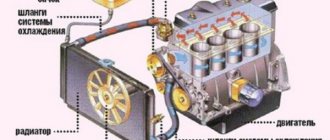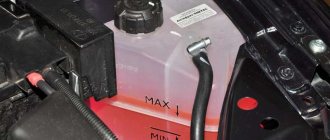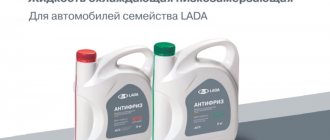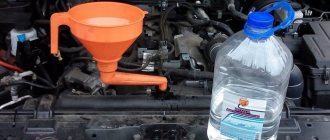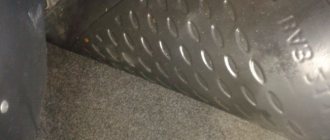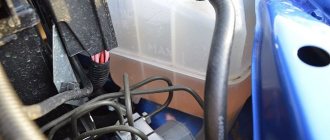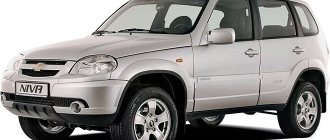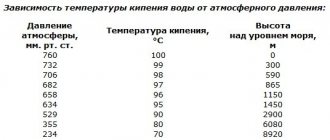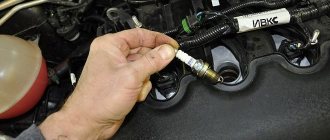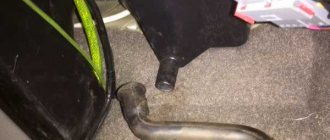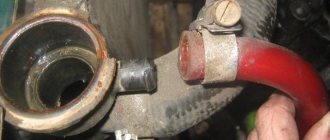Instructions for replacing antifreeze on Lada
First of all, you need to purchase the necessary consumables.
To replace antifreeze on a Lada Grant, as well as to replace antifreeze on a Lada Kalina, 10 liters of refrigerant is enough. To replace the Lada Largus antifreeze you will need 7-8 liters. The brand of antifreeze (antifreeze) is usually indicated by the manufacturer on the expansion tank or in the service book. Instructions for replacing Lada antifreeze:
- Remove the crankcase protection to gain access to the engine. Substituting a bucket, unscrew the drain bolt, which is located at the bottom of the engine block. On domestic cars, you will need a key “13” for this;
- After all the liquid has escaped, tighten the bolt and begin to drain the liquid from the radiator;
- On vehicles without air conditioning, there is a special drain plug in the radiator. If it is installed on your car, you need to loosen the clamp, remove the lower hose from the radiator fitting and install it back after draining;
- After the liquid has been drained, use a Phillips screwdriver to loosen the clamp on the throttle body heating hose (the highest point of the car's cooling system). After loosening, disconnect the hose from the fitting;
- Now pour coolant into the expansion tank until liquid begins to flow from the disconnected hose;
- After this, quickly attach the hose back, carefully tighten the clamp and add fluid to the required level (the “max” mark on the tank).
Now you can start the car and check all the places where the fluid was drained. If tightened correctly, there should be no leaks, but if they appear, tighten the clamps more tightly.
Lada Granta
A distinctive feature of replacing antifreeze on an 8-valve Grant is the mileage; the coolant is replaced more often than on a 16-valve car. And when replacing antifreeze on a Lada Grant 16-valve, you should pay attention to the location of the drain bolts. On a vehicle with a 16-valve engine, access to the drain hole is blocked by the starter
In addition, the leaking liquid will inevitably get inside the starter. Therefore, when replacing antifreeze, it will be necessary to remove the starter; to do this, use a “13” key to unscrew the nut and disconnect the tip of the power wire
On a vehicle with a 16-valve engine, access to the drain hole is blocked by the starter. In addition, the leaking liquid will inevitably get inside the starter. Therefore, when replacing antifreeze, it will be necessary to remove the starter; to do this, use a “13” key to unscrew the nut and disconnect the tip of the power wire.
Lada Kalina
To access the drain bolt in cars, when replacing the antifreeze of the Lada Kalina 8 valve, you need to remove the ignition coil along with the bracket. To do this, you need to disconnect the battery and engine splash guard. Then, using the “15” key, unscrew the ignition coil bracket and carefully remove the coil with the bracket. Having gained access, unscrew the drain bolt and drain the liquid. After draining the antifreeze, install in the reverse order.
First of all, you need to purchase the necessary consumables. To replace antifreeze on a Lada Grant, as well as to replace antifreeze on a Lada Kalina, 10 liters of refrigerant is enough. To replace the Lada Largus antifreeze you will need 7-8 liters. The brand of antifreeze (antifreeze) is usually indicated by the manufacturer on the expansion tank or in the service book.
It is advisable to change the brand of coolant only when flushing the cooling system, since manufacturers add various impurities that can precipitate when stirred. Thus, the cooling system will quickly become clogged, the pump may fail, and the car will begin to overheat.
Lada Granta
On a vehicle with a 16-valve engine, access to the drain hole is blocked by the starter. In addition, the leaking liquid will inevitably get inside the starter. Therefore, when replacing antifreeze, it will be necessary to remove the starter; to do this, use a “13” key to unscrew the nut and disconnect the tip of the power wire.
Lada Kalina
To access the drain bolt in cars, when replacing the antifreeze of the Lada Kalina 8 valve, you need to remove the ignition coil along with the bracket. To do this, you need to disconnect the battery and engine splash guard. Then, using the “15” key, unscrew the ignition coil bracket and carefully remove the coil with the bracket. Having gained access, unscrew the drain bolt and drain the liquid. After draining the antifreeze, install in the reverse order.
Instructions for changing the coolant in a car
The first thing you should start with when updating the coolant is choosing the right brand of product . When replacing antifreeze in Lada Largus, the same type of fluid is used. Mixing different means for engine cooling is strictly not recommended - this leads to very unpleasant consequences, including serious damage. It is worth remembering that domestic manufacturers often call antifreeze antifreeze . But antifreeze is a type of antifreeze, and it is not suitable for every engine.
In Lada Largus models, it is recommended to use “GLACEOL RX” coolant (type D) - this is a recommendation issued by the vehicle manufacturer. Moreover, dilution with water is allowed only as a last resort . Antifreeze poured into the cooling system contains a set of additives to combat corrosion. And when diluted, these additives lose their effectiveness. to top up the coolant with distilled water in the summer, in extreme heat. In such a situation, the water contained in the product evaporates and the level of antifreeze in the system decreases. And it is restored by adding the required level of distilled water.
To carry out the replacement, it is necessary to place the car in an inspection hole or on an overpass. It is recommended to follow safety precautions to avoid injury and property damage:
The first step in replacing the coolant is draining the used antifreeze from the system . First you need to remove the plate , which is the engine protection (power unit protection). It is located at the bottom and is supported by six fasteners. They are unscrewed with a standard "10" wrench. It is recommended to carefully remove the bolts so as not to lose them during maintenance. Access to the bottom of the radiator is provided. Experienced motorists recommend checking whether the thermostat is working properly (if the system is overheating) and whether there are any leaks in order to make repairs in time if necessary.
In the case of Lada cars (including Lada Largus), the cooling system does not have a special hole for draining antifreeze. It has to be drained through a hose from the radiator . But first you need to remove the expansion tank cap (unscrew it manually) and relieve pressure in the system. Then the lid is put back on. Before draining the antifreeze, you need to prepare a container with a volume of at least six liters - the used coolant will go into it. Now you need to take pliers or pliers, loosen the clamp on the hose going to the radiator, and then disconnect this hose. You should act carefully - the liquid will flow immediately.
The second stage of cooling system maintenance is to completely clean it. Flushing the cooling circuit can be done at home, if you have the necessary cleaning products. There are three ways to clean the system:
The system flushing process itself looks like this:
In case of heavy contamination, the procedure is repeated several times until the dirt, scale, etc. is completely removed. After cleaning, you need to start pouring new antifreeze.
The last, third stage is filling the cooling system with new antifreeze. First, the hose from the radiator pipe is fastened into place (you should definitely tighten the clamp to secure it). Then the cap of the fitting on the hose is unscrewed , through which the antifreeze is supplied to the Lada “stove”. Now you should start pouring liquid into the system. At a certain point, antifreeze will begin to pour out of the fitting. close the hole no earlier than a uniform, continuous stream ! Otherwise, air will remain in the system: it will lead to a decrease in the efficiency of the circuit (almost to a minimum).
After closing the fitting, it is necessary to fill the cooling system with antifreeze to the required maximum level (there is a mark in the expansion tank indicating the maximum). The reservoir closes and the engine starts. It is necessary to warm up the engine well, periodically increasing the speed to 2.5-3 thousand. During the process, it is worth turning on the stove (if the system is operating normally, it will give an even flow of hot air). After the engine has warmed up, it is worth rechecking the system for leaks. If no problems are found, this means that the antifreeze was replaced successfully.
Stages of replacing coolant Lada Largus
Fuel filter Lada Largus
So that the new coolant lasts a long time and does not turn into brown sludge after a couple of months. The replacement process should consist of three stages: draining, rinsing, filling. Without a flushing step, there is a possibility that the new antifreeze will quickly lose its properties.
Lada Largus cars are equipped with 1.6 liter petrol engines:
- 8 valves - K7M (VAZ-11189);
- 16 valves - K4M (VAZ-21129).
There are slight differences between them in the cooling system. On the 8 valve there is a drain hole on the engine block, but it is located in a hard-to-reach place. For this reason, not everyone will decide to drain the cylinder block, because to do this you need to remove the starter.
Coolant drain
It is more convenient to drain old antifreeze from a technological pit or on an overpass. Therefore, we drive our Lada Largus into a garage with a pit. And while the engine is cooling, we go down to unscrew the engine protection. It is secured with 6 bolts under a 10mm head.
The preparations have been completed, now we move on to draining:
- Unscrew the cap on the expansion tank (Fig. 1).
This way, almost all the antifreeze in the cooling system is drained. Now, for the best result, let's flush the system. So that fresh coolant lasts as long as possible.
Flushing the cooling system
At the washing stage, we need to decide why we are doing it. If sediment, suspensions or flakes are found in the drained liquid, then special means are needed. There are a large number of them sold and each has its own instructions to follow.
To flush the Lada Largus system from small deposits and old antifreeze, ordinary distilled water is suitable. We put all the hoses in place, fill the system through the expansion tank and close the lid.
Now you need to start the car and drive the engine until it warms up completely; you can occasionally increase the speed so that the temperature rises faster. After warming up, turn off the engine, wait for it to cool down a bit and drain the water.
Filling without air pockets
After flushing and draining as much as possible according to the instructions, a little distilled water still remains in the cooling system. Using antifreeze to fill in this situation, it will mix with water and the freezing point will change. For this reason, it is better to use a concentrate; it can be diluted taking into account the remaining water in the system.
In order to get rid of air pockets, we find a fitting for releasing air on the hose going to the stove. Unscrew the plug and connect a transparent hose to it. The second end of which is inserted into the expansion tank. Pour in the finished liquid, just like we did at the stage above (Fig. 5).
Now all that remains is to start the engine, the antifreeze will return through the connected hose to the expansion tank, and the air will return to the atmosphere. You just need to watch the level in the tank so that it does not drop and the system does not become airy.
It is convenient to see through the transparent hose when all the air has escaped. Then remove the hose and put the protective cap in place. In this way, it is possible to completely get rid of air jams on the Lada Largus. All that remains is to check the fluid level in the next few days; if it drops, top it up.
How to replace antifreeze?
Replacement of antifreeze is carried out when the engine has cooled down.
Where is the cabin filter located on Largus
Lada Largus where is the fuel filter located?
Air filter for Largus
Let's get started.
- We install LADA Largus over the inspection ditch.
- After waiting for the engine to cool, unscrew the cap on the expansion tank in order to relieve residual pressure in the circuit.
- Working from underneath the car, remove the crankcase protection and set it aside.
- Note that the main radiator of the system, as well as the engine block, in this model do not have special plugs that allow you to drain the waste fluid conveniently and to the maximum extent possible.
- We install a container under the radiator pipe that is capable of “accepting” at least 6 liters of old refrigerant. We take pliers and squeeze the ends of the clamp holding the hose on the lower radiator pipe.
- Move the clamp and remove the pipe. We act carefully so as not to get doused with antifreeze. At the initial stage of draining, we recommend completely closing the cap on the expansion tank. This will reduce the pressure of the antifreeze discharged into the container. As the drain progresses, the lid can be gradually opened.
- After the entire volume of refrigerant has drained, we put the hose back in its original place and secure the connection with the same clamp.
- Before the filling process, remove the cap from the fitting that is present on the refrigerant supply hose to the heater radiator.
- We pour the liquid into the cavity of the expansion tank and watch how it penetrates the system. We do this until liquid begins to flow from the open fitting, forming a solid stream. Under no circumstances should there be air bubbles, otherwise a traffic jam is guaranteed to be created, which will then reduce the entire efficiency of the system to “zero”.
- Close the fitting plug and fill the tank to the mark indicating the maximum level.
- We start the LADA Largus engine, warm it up a little, periodically raising the speed to 2500-3000 per minute. This allows any remaining air (if there is any) to be removed from the system. As the engine warms up, we turn on the heating in the cabin and notice a hot stream of air “escaping” from the deflectors.
- We turn off the unit, let it cool and inspect the system for leaks. The coolant replacement is complete.
What fluid is recommended by the manufacturer?
Replacing the timing belt on Lada Largus 8/16 valves
What antifreeze is usually poured into this model? Regarding the Lada Largus model, the developers recommend using refrigerant produced under the GLACOEL RX brand. The type of liquid itself must correspond to the so-called “D-class”. It involves the manufacture of a substance using ethylene glycol as a base, to which water (distillate) is added in a specific proportion.
The experience of the owners indicates the use of Motul Inugel Optima Ultra antifreeze as an analogue. This type of refrigerant is used by some manufacturers of foreign cars. In general, the final decision is yours, but you can rely on the experience of car owners about what kind of antifreeze is used by experienced drivers.
How much antifreeze should I fill?
Filling volumes of Lada Largus 8 valves
The total amount of coolant that is poured into a Largus with air conditioning is 5.45 liters. In Largus without air conditioning you need to fill less - 4.5 liters.
| Year | Engine | Type | Color | Lifetime | Recommended Manufacturers |
| 2012 | for all | G12++ | red | from 5 to 7 years | Freecor QR, Freecor DSC, Glysantin G 40, FEBI |
| 2013 | for all | G12++ | red | from 5 to 7 years | FEBI, VAG, Castrol Radicool Si OAT |
| 2014 | for all | G12++ | red | from 5 to 7 years | Frostschutzmittel A, FEBI, VAG |
For diesel and gasoline engines the parameters will be the same!
When purchasing, you need to know the shade - the Color and Type of antifreeze allowed for the year of manufacture of your Largus. Select the manufacturer at your discretion. Do not forget - each type of liquid has its own service life.
For VAZ Largus (1st generation) 2012, with any type of engine, it is suitable for lobrid class antifreeze, type G12++ with shades of red. The approximate period of the next replacement will be 7 years.
If possible, check the selected fluid against the vehicle manufacturer's specifications and service intervals.
Each type of liquid has its own color. There are rare cases when the type is tinted with a different color. The color of red antifreeze can be from purple to light pink (green and yellow have the same principles).
It is possible to mix liquids from different manufacturers if their types meet the mixing conditions.
G11 can be mixed with analogues of G11 G11 cannot be mixed with G12 G11 can be mixed with G12+ G11 can be mixed with G12++ G11 can be mixed with G13 G12 can be mixed with analogues of G12 G12 cannot be mixed with G11 G12 can be mixed with G12+ G12 cannot be mixed with G12++ G12 cannot be mixed with G13 G12+ , G12++ and G13 can be mixed with each other. Mixing antifreeze with antifreeze (traditional class coolant, type TL) is not allowed. No way! Before completely changing the type, rinse the radiator with plain water. At the end of its service life, the liquid becomes discolored or becomes very dull. Antifreeze and Antifreeze are very different in quality. Antifreeze is the trade name of the traditional type (TL) of the old-style coolant.
How often should I change
A liquid that is resistant to low temperatures is used to cool the engine. In the CIS countries, the name “antifreeze” has taken root, but it is a separate liquid in the car.
The composition of antifreeze is water with glycerin, alcohol, ethylene glycol or propylene glycol, and various additives. Exposure to high temperatures can change the chemical composition of the mixture
In this regard, it is important to remember after how long to replace the coolant. According to the international classification, there are three types of coolant: G11, G12, G13 (silicate, organic acids or propylene glycol)
In this regard, the question arises, how often to change the coolant? It depends on the type of antifreeze, more on that below. In the meantime, let's consider situations when you need to change antifreeze urgently, without waiting for time to expire:
- significant clouding of the refrigerant, change in its color;
- the appearance of sediment, flakes, mechanical particles in the coolant;
- increased foaming;
- thickening - antifreeze becomes like jelly;
- significant reduction in fluid volumes;
- adding antifreeze of a different standard.
It is also worth saying that in older cars with high mileage, antifreeze requires more frequent replacement than in new ones. This is due to the fact that corrosion spots inevitably form in the engine over time. Antifreeze tries to neutralize them, absorbing rust particles and losing their beneficial properties. In this case, the need for replacement will be indicated by a rusty tint of the liquid.
Antifreeze manufacturers always indicate on the product packaging the recommended replacement period. Usually, after this period, the first warning signs appear, signaling a deterioration in quality.
These intervals depend on the production technology and the liquid standard (if you use the classification of antifreeze from the Volkswagen concern, borrowed by many manufacturers):
- G11. This standard includes traditional antifreezes. They use inorganic additives - silicates and other substances. Their peculiarity is that they form a physically tangible layer on the inner surface of parts, which prevents the formation of pockets of corrosion. If you do not change such antifreeze on time, this layer begins to precipitate, the protection deteriorates, and the fallen particles clog the system components. This happens faster than with other antifreezes. The recommended replacement interval is 2 years. TOSOL also has similar properties, so its replacement period will be similar.
- G12. This standard is used to designate coolants produced using organic (carboxylic) acid technology. The resulting liquid has excellent heat transfer properties and does not create any layer, like traditional ones. Its corrosion inhibitors act in a targeted manner. They are directed to where pockets of corrosion occur and prevent their further spread. However, over time, carbon fibers lose their grip, corrosion spreads, and the properties of antifreeze deteriorate. It is recommended to change them every 5 years. The same applies to improved carboxylate antifreezes - G12 and hybrid - G12.
- G13. This is the newest generation of coolants called lobrid. The main difference is that it is based on propylene glycol (the rest use ethylene glycol), a more environmentally friendly and more reliable base. Otherwise, they are similar to carboxylate ones. Such fluids have the longest service life - from 5 to 10 years, and some manufacturers recommend not changing the coolant at all throughout the entire service life of the cooling system.
labavto.com
During the operation of an internal combustion engine, a significant amount of heat is released, which requires its removal, which means a reliable cooling system is needed. In Lada Largus, heat is removed due to the circulation of antifreeze. The service life and efficiency of the engine depend on its quality. Therefore, it is necessary to change it in a timely manner. Even a novice car enthusiast can cope with replacing the coolant on a Lada Largus, using step-by-step instructions for the procedure.
Use of antifreeze and reasons for its replacement
Many car enthusiasts do not understand the importance of antifreeze, believing that simple water from the tap can handle the cooling. The difference lies in the complex chemical composition of the refrigerant. During operation, the engine heats up to high temperatures, the task of antifreeze is to remove excess heat and maintain the operating temperature of the engine - about 90 degrees.
Ordinary water is not suitable for these purposes, since at a temperature of 100 degrees it begins to boil and evaporate. In this case, to maintain the system at the required liquid level, frequent addition of water will be required, which creates inconvenience during operation. In addition, the water contains various impurities that settle on the walls and internal parts of the power unit, radiator and lines. This can disrupt proper heat exchange, which can lead to engine overheating.
Antifreeze is used as a refrigerant on the Lada Largus. To prevent the engine from overheating during vehicle operation, the cooling system must be in good condition and filled with high-quality refrigerant. Otherwise, the rubbing parts of the power unit will not cool in time, which will lead to its overheating and failure. Overhauls take a lot of time, effort and are expensive. Therefore, you need to monitor the condition of the cooling system and refrigerant.
Tips for coolant replacement intervals
In the manual of the Lada Largus car, the manufacturer requires a routine replacement of the coolant after 35-45 thousand kilometers or after two years of operation. The timing depends on which event occurs first.
The frequency of coolant replacement is influenced by the following factors:
- antifreeze quality;
- chemical composition;
- performance characteristics;
- manufacturer.
The latter set their own deadlines for the released product. On average, manufacturers recommend changing the coolant once a year. The frequency of replacement also depends on operating conditions, the technical condition of the car, and the driver’s driving style. Therefore, mileage does not play a major role. The serviceability of the cooling system and the quality of antifreeze are also important. This is especially true for the Lada Largus, since it has an aluminum radiator.
You can decide whether to replace the coolant by determining its quality. In garage conditions, you can use the following methods:
| Method | How to check |
| Visual inspection | Coolant that has lost its basic qualities contains various foreign mechanical inclusions in the form of limescale, sludge, flakes, suspensions, etc. Antifreeze becomes cloudy, which indicates that it needs to be changed urgently. |
| Boiling | The quality of the coolant can be checked by bringing it to a boil. To do this, you can take a minimum amount of antifreeze. Pour the liquid into a tablespoon and bring to a boil while holding it over a gas burner. If after boiling a strong smell of ammonia (ammonia) appears, then this is counterfeit or low-quality antifreeze. It's better not to fill it. A more dangerous refrigerant in which, when heated, a precipitate of copper sulfate in the form of granules appeared. If such antifreeze is poured into a car, the granules will fill the channels, which will impede the circulation of the liquid and lead to overheating of the engine. |
| Test strips | The test is carried out using litmus paper, which can be purchased at any auto store. Sometimes it is sold together with antifreeze. To check, a litmus strip with a reagent applied is dipped into the refrigerant. Then wait a few minutes and take it out. Drawing conclusions about the staining results should be guided by the manufacturer’s instructions. |
How to choose the right antifreeze
High quality refrigerant is able to maintain its characteristics for a long period of time, regardless of the conditions in which the machine is operated. There are brands of antifreeze whose manufacturer promises that replacement will be required only after 100 thousand kilometers. Naturally, they are more expensive than conventional coolants.
It is important to choose the right refrigerant, which will extend the life of the motor and components of the cooling system. Manufacturers recommend using GLACOEL RX class D antifreeze for Lada Largus.
This refrigerant uses ethylene glycol as a base. Distilled water is added to it in the required proportion and special additives are added. Analogues can be used.
Antifreezes are divided into mineral G-11 and organic G-12. The first is used in used cars, the second is poured into modern new cars. Antifreezes differ in the color of the liquid. Color determines the set of properties inherent in a given refrigerant. It is not recommended to mix liquids of different colors, as such a mixture can harm the cooling system. Therefore, you need to buy coolant of the same color that was filled in.
Changing the fluid yourself: step-by-step instructions
To replace, you will need at least 6 liters of antifreeze, since the cooling system of the Lada Largus car holds 5.45 liters of coolant. Experienced drivers recommend having a supply of antifreeze poured into the system for unforeseen situations that may arise on the road: fluid leakage due to depressurization of system components.
Work must be carried out on a cooled engine. If the car is after a trip, you need to wait until the engine cools down completely.
Draining and filling antifreeze on the Lada Lagrus consists of a sequence of actions:
- We place the car on a lift or a flat viewing platform. We fix the wheels to avoid rolling away.
- Raise the hood to gain access to the engine compartment. We de-energize the car by removing the negative terminal from the battery.
- Unscrew the cap from the expansion tank to relieve excess pressure. For safety reasons, you need to wear gloves. If the motor is not cool enough, steam may come out from under the cover.
- We go to the bottom of the car and remove the protection from the engine, if it is installed.
- We install a container with a volume of at least 6 liters under the radiator pipe to drain the old coolant. The design of the Lada Largus does not provide a drain hole with a plug, so the coolant will have to be drained by loosening the clamps on the lower radiator pipe.
- Using sliding pliers, we compress the ends of the clamps that hold the hose to the radiator pipe.
What does the manufacturer recommend?
AvtoVAZ recommends using certain brands of antifreeze for all its cars, which should be filled when replacing the factory coolant. Among such manufacturing companies the following can be noted:
This is what is sold at most gas stations.
For the Lada Largus car, the manufacturer recommends using GLACOEL RX antifreeze. In this case, the brand of liquid must correspond to D-class. It is made from ethylene glycol and water.
Some car enthusiasts prefer Motul Inugel Optima Ultra antifreeze. This type of antifreeze is poured from the factory for foreign-made cars.
Mixing antifreeze
It's better not to interfere. The photo shows foaming of the coolant as a result of pouring different types of antifreeze
This question worries a fairly large number of Lada car owners. It is difficult to answer this question unambiguously, since some manufacturers color their liquid in accordance with its chemical composition, while others color it at their own discretion.
Most car enthusiasts never mix coolants of different colors. Half of car owners believe that if you mix liquids of different colors, nothing bad will happen.
The operating instructions for the Lada Largus car indicate that the manufacturer may add a coloring agent to the antifreeze, which can have a certain effect on its chemical composition.
Therefore, when choosing it, you need to pay attention not to the color of the liquid, but to its composition. You should also follow the recommendations of the car manufacturer when choosing
You should also follow the recommendations of the car manufacturer when choosing.
In the case where the antifreeze will be sold concentrated, it must be diluted with distilled water, which should be added in certain proportions. Such proportions are usually indicated on the packaging.
Completely changed the antifreeze on Largus
A short note about when, where and how long it took to change antifreeze on a Lada Largus. Largusovod's report on costs in 2021. What does the new NRC packaging look like?
Topping up from Togliatti gradually ended. The fluid level has approached the minimum mark. The mileage on Larick has exceeded 113,000 km. It was impossible to pull. I went to the service station to change the antifreeze. According to the regulations, the coolant should have been changed at another 90 thousand, or after six years of operation. Six is the alphabet number. Despite the fact that the shelf life is five years.
Signed up. I found a free day. On Monday morning, through traffic jams, I arrived at the appointed time.
From a conversation at the reception
I went into the office. They were waiting for me.
- Yes, please take a seat. Let's clarify the details: are you replacing the coolant?
- Yes that's right. How much money?
— The work will cost 700 rubles. Antifreeze 225 rub. per liter of original Coolstream NRC. You will need 5 liters. Liter per refill.
- Another question. There is sediment in the tank. Maybe rinse it some more?
- Yes, it’s possible. Flushing the system with distilled water will cost 640 rubles.
- OK, let's take it. What about time?
— Time to work is about an hour. Will you be attending?
- Why not. Will. (author’s note: I’m pinned down, I need to stand over my soul. There’s a sofa and a TV there)
- Then now the car will be driven into the box. Please wait in the waiting area.
Replacement
I'm inside the box. Entered through the service door. There are two more cars nearby: Largus Cross and Duster. The receiver introduced the master. Turned out to be a burden
Which doesn't really matter
The technician started by draining the old fluid. Disconnected the upper hose from the tank. It was a steam exhaust hose. I dropped it into an empty canister. In its place I stuck a hose with compressed air. He began to expel the antifreeze into the canister. The process took about 5-7 minutes. I didn’t really detect it.
New antifreeze packaging
Then the washing began. The hose was put back in place. The drain valve cap is unscrewed. Alexander poured water into the tank. It took almost 5 liters. There are 100-200 ml of this “small” left in the five-liter bottle.
A thin tube was led directly from the drain valve into the tank. The engine is started. We circulated water through the system for about 15-20 minutes. From the fitting through the tube back to the tank.
At the end of the washing process, the water began to drain. The upper hose goes back into the canister. Compressed air was blown into the tank.
When the water was drained from the canister, the contents turned out to be cloudy.
The last stage: filling in new antifreeze. Run through the system with the engine running. Topping up in progress. Gradually the entire canister was gone. This is 5 liters.
Fashionable NRC antifreeze canister in full view
Tolerances and conformities are indicated. Renault 41-001/—T. Cars B0: Lada Largus, X-Ray, Nissan Terrano, new Almera.
She's in profile. There are a lot of letters here. I'll decipher it a little
Coolstream NRC is a 100% carboxylate antifreeze, specially developed to meet Renault's technical requirements. Selected for conveyor filling at factories in Russia in Lada Largus, X-Ray, and all Renault models. Does not have an aggressive effect on pipes. Prevents foaming and scale formation. Does not contain silicates, amines and salts. Contains ethylene glycol, demineralized water and Belgian Arteco additives.
They gave me a bottle to refill. For some reason I remembered draft and foamy.
The sixth liter will be refilled during the next five-year plan.
Results. In fact, it took 5 liters. Without 100 ml. Time to work is a little over an hour. RUB 2,564 spent.
We change it ourselves
If you quote the Largus repair and operation manual, you need to do the following:
- Enter a lift or pit
- Remove the central pan
- Disconnect the hose from the lower radiator pipe and drain the liquid into a canister
- Remove the plug from the expansion tank
- After draining, attach the hose to the radiator pipe
- Fill with new fluid up to the Maxi mark
- To better fill the system with liquid and remove air from it, unscrew the drain valve cap. Wrap after liquid appears
2271-3-7-07-03 (Copy)
We fill until the liquid begins to flow out through the air outlet fitting. We wrap the cap of the air release fitting and the cap of the expansion tank.
Let's start the engine. When the engine warms up, the outlet (lower) radiator hose should be cold for some time, and then quickly heat up, which will indicate the beginning of fluid circulation in a large circle. After waiting for the cooling system fan to turn on, stop the engine. After the engine has cooled, check the coolant level. If necessary, we bring it to normal.
What fluid is recommended by the manufacturer?
What antifreeze is usually poured into this model? Regarding the Lada Largus model, the developers recommend using refrigerant produced under the GLACOEL RX brand. The type of liquid itself must correspond to the so-called “D-class”. It involves the manufacture of a substance using ethylene glycol as a base, to which water (distillate) is added in a specific proportion.
The experience of the owners indicates the use of Motul Inugel Optima Ultra antifreeze as an analogue. This type of refrigerant is used by some manufacturers of foreign cars. In general, the final decision is yours, but you can rely on the experience of car owners about what kind of antifreeze is used by experienced drivers.
Antifreeze quality check
You should not trust the numbers on the canister; the indicated replacement period on the packaging does not always correspond to reality. Relying on these figures, it is easy to find yourself in a situation where the antifreeze, having exhausted its service life, ceases to perform its functions. And this will inevitably lead to overheating of the power plant, although replacement is not yet necessary. But you can avoid such situations and the troubles that follow.
It is recommended to learn how to independently determine the quality of antifreeze in the cooling system and, based on this check, make a decision about replacing the fluid.
There are about ten ways to determine quality, but not all of them are available to the average car owner. At home, you can check the coolant yourself using three main methods, which are the simplest and do not require financial investment.
We check it ourselves
| Methods | Your actions |
| Test strips. | Litmus test is familiar to many people from school in chemistry lessons. They can be purchased at any auto parts store; some manufacturers offer them along with antifreeze as an addition. The test is simple: you need to dip a test strip with a reagent in antifreeze, wait five minutes and evaluate the staining result using the operating instructions. This way you can estimate the time until the next replacement. |
| Visual inspection. | Antifreeze that has lost its basic properties can be easily identified by the presence of various foreign impurities (flakes, sediment, sludge, limescale, etc.). The quality can also be judged by the color of the liquid: a cloudy color indicates the need for an early replacement. |
| Boiling. | To check quality, you can boil antifreeze. It is worth using a small amount of liquid, for example, heating a tablespoon with coolant on a gas burner or stove. If the smell of ammonia (ammonia) is clearly felt when boiling, it means the antifreeze is of low quality or it is a fake. It is better not to use such liquid. It is much more dangerous when a precipitate of copper sulfate granules forms when heated. When using such a liquid in a car, the granules will clog the cooling system channels, which will ultimately lead to overheating of the power unit. |
Knowing these simple methods, you can quickly determine the quality of the coolant at home. This way you can avoid problems with a low-quality product.
Rules for choosing coolant
The cooling system of the Lada Largus car holds 5.45 liters of antifreeze, it is recommended to purchase at least 6 liters for replacement; the remaining volume can be used for topping up during operation or if leaks occur (broken pipe, loss of radiator tightness, leakage due to weak clamps and etc.).
For the Lada Largus, the manufacturer recommends filling in Glacoel RX brand coolant; this is the antifreeze that is filled in at the factory. When choosing an alternative option, it should be taken into account that the liquid must correspond to D-class. This means that it is produced on the basis of ethylene glycol, to which a distillate, most often water, is added. As an analogue, you can use the Motul Inugel Optima Ultra brand. A similar brand is also used on Renault cars. In general, you can choose another option from a large assortment, the main thing is that it matches the basic parameters.
Question about mixing
Many motorists doubt whether it is possible to mix different antifreeze. Such questions arise due to the fact that some manufacturers use the same antifreeze (i.e., the chemical composition is identical), but compositions of different colors are used as dyes. As it were.
Mixing refrigerant of different colors, much less different brands, is not allowed.
The fact is that antifreezes with different chemical compositions, when mixed, can do more harm than good. Some car owners experiment with various refrigerants at their own risk. But repeating their actions is not recommended.
In the operating manuals of many cars and Lada Largus in particular, it is written that manufacturers of coolant for painting add a special component to the composition. But the color of the stain will depend on the specific chemical composition of the liquid. When choosing by color, it is also recommended to focus on the shade of the factory refrigerant.
Signs that the procedure is necessary
Antifreeze is used as a coolant in the Lada Largus car. Its main purpose is to maintain the normal temperature of the power plant due to heat removal. A malfunction of the cooling system or low-quality antifreeze can lead to the fact that internal combustion engine parts, creating enormous thermal energy through friction during operation, will not be able to cool in a timely manner. The further development of the situation is predictable.
All this leads to the most dangerous condition: engine overheating, as a result of which the internal combustion engine fails.
A major overhaul will be required, which is not inexpensive, and the process is labor-intensive. To avoid such troubles, an effective cooling system was created. One of its most important components is antifreeze. It is directly involved in heat exchange.
Reasons for using antifreeze
Many motorists, especially beginners, do not understand: why use antifreeze if ordinary water can cope with its task? It's all about the difference in chemical composition. The refrigerant is a complex chemical liquid, and this is not due to the desire of manufacturers to sell the product as expensive as possible by using more chemicals.
During engine operation, antifreeze is exposed to high temperatures, we are talking about 100 degrees or more. Any other liquid, especially water, at such temperatures begins to boil and, accordingly, evaporate. In other words, to maintain the optimal level, you will have to constantly add new fluid to the system, which is not very convenient. In addition, water contains various impurities, which, due to high temperatures, are deposited in the form of scale on the engine jacket and in the radiator, which ultimately leads to disruption of heat transfer and overheating.
Coolant replacement intervals
In modern realities, choosing an antifreeze that is ideally suited to the operating mode of a power plant is not easy due to the huge range and constantly changing technologies.
The service life, and therefore the time from one replacement to another, will be largely determined by:
- chemical composition;
- characteristics;
- the cost of a product of a particular brand.
If we refer to the manufacturers, the replacement frequency is on average once a year or depending on the mileage set by the manufacturer. For Lada Largus, the car plant's regulations provide for from 35,000 to 45,000 kilometers.
In this case, one should take into account the nature of driving, the technical condition of the engine and operating conditions. If there are negative operating factors, replacement may be carried out earlier. In this matter, you should not focus only on the mileage on the speedometer. In addition, the quality of antifreeze is also of great importance; if the cooling system is faulty, low-quality antifreeze can aggravate the situation. You cannot rely on mileage on Largus cars, which use an aluminum cooling radiator.
High-quality modern antifreeze for Lada Largus, thanks to some components in the composition, is able to retain its properties for a long time, regardless of operating conditions. For example, some brands of antifreeze, according to the manufacturer, do not need to be replaced for at least 100,000 kilometers. Such new generation products naturally cost much more, but this will determine how often the car owner will have to change the coolant. Another plus is that even a beginner can easily find the expansion tank with this liquid by opening the engine compartment. A characteristic feature is that it comes in different colors (blue, green, red).
